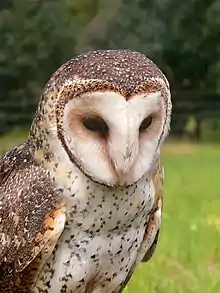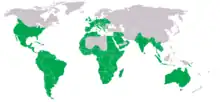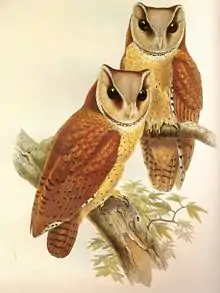Barn-owl
Barn-owls (family Tytonidae) are one of the two families of owls, the other being the true owls or typical owls, Strigidae. They are medium to large owls with large heads and characteristic heart-shaped faces. They have long, strong legs with powerful talons. They also differ from the Strigidae in structural details relating in particular to the sternum and feet.[1]
| Barn owls Temporal range: Late Eocene to present | |
|---|---|
 | |
| Australian masked owl (Tyto novaehollandiae) | |
| Scientific classification | |
| Domain: | Eukaryota |
| Kingdom: | Animalia |
| Phylum: | Chordata |
| Clade: | Dinosauria |
| Class: | Aves |
| Order: | Strigiformes |
| Family: | Tytonidae Ridgway, 1914 |
| Genera | |
| Synonyms | |
| |
Barn-owls are a wide-ranging family, although they are absent from northern North America, Saharan Africa, and large parts of Asia. They live in a wide range of habitats from deserts to forests, and from temperate latitudes to the tropics. Within these habitats, they live near agricultural areas with high amounts of human activity.[2] The majority of the 20 living species of barn-owls are poorly known. Some, like the red owl, have barely been seen or studied since their discovery, in contrast to the common barn-owl, which is one of the best-known owl species in the world. However, some subspecies of the common barn-owl possibly deserve to be separate species, but are very poorly known.
Five species of barn-owl are threatened, and some island species went extinct during the Holocene or earlier (e.g., Tyto pollens, known from the fossil record of Andros Island in the Bahamas, and possibly the basis for the mythical chickcharney).[3] Barn-owls are mostly nocturnal and generally non-migratory, living in pairs or singly.
Taxonomy and systematics
Barn-owls consist of two extant subfamilies: the Tytoninae or Tyto owls (including the common barn owl) and the Phodilinae or bay owls. The modern genera Tyto and Phodilus are thought to have originated from a common ancestor from the Oligocene period.[4] It is believed the modern genus Tyto descended from large nocturnal birds in the West Indies during the Quaternary. The systematics of this group began with the discovery of Tyto ostologa (now extinct), whose remains were found in north-central Haiti. This discovery led to the finding of Tyto pollens, Tyto noeli, and Tyto riveroi in nearby cave deposits, all of which are now extinct and were also considered giant.[5][6] The Sibley-Ahlquist taxonomy unites the Caprimulgiformes with the owl order; here, barn-owls are a subfamily, Tytoninae. This is unsupported by more recent research (see Cypselomorphae), but the relationships of the owls in general are still unresolved.
Extant genera
Two extant genera are recognized:[7]
Genus Tyto

Some of the Tyto species that exist include the common barn owl (Tyto alba), the American barn owl (Tyto furctata), the Australian barn owl (Tyto delicatula), and the Eastern Barn Owl (T. javanica). Within each of these species, there are many subspecies. Of the common barn owl there are 10 subspecies: T. alba affinis, T. alba alba, T. alba erlangeri, T. abla ernesti, T. alba gracilirostris, T. alba guttata, T. alba hypermetra, T. alba javanica, T. alba schmitzi, and T. alba stertens. Of the American barn owl, there are 5 subspecies: T. furcata attempta, T. furcata furcata, T. furcata hellmayri, T. furcata pratincola, and T. furcata tuidara. Of the Australian barn owl, there are 4 subspecies: T. delicatula delicatula, T. delicatula interposita, T. delicatula meeki, and T. delicatula sumbaensis.[8]
The common barn owl (T. alba) can be found in Africa and parts of Asia, including Eurasia. The American barn owl (T. furcata) can be found from North to South America. Lastly, the Australian barn owl (T. delicatula) can be found in Australia, New Zealand, Polynesia, and Asia.[4]

Genus Phodilus
This genus includes the Oriental bay owls (P. badius) and the Sri Lanka bay owls (P. assimilis).[4] Bay owls have a much smaller distribution than genus Tyto, with Oriental bay owls (P. badius) found in tropical Asia and Sri Lanka bay owls (P. assimilis) found in Sri Lanka and southwestern India.[9]
Extinct genera
The fossil record of barn-owls goes back to the Eocene, with the family eventually losing ground to the true owls after the radiation of rodents and owls during the Neogene epoch. Two subfamilies are known only from the fossil record: the Necrobyinae and the Selenornithinae. At least four extinct genera of barn-owls have been described:
- Genus Nocturnavis (Late Eocene/Early Oligocene) – includes Bubo incertus
- Genus Necrobyas (Late Eocene/Early Oligocene – Late Miocene, France) – includes Bubo arvernensis and Paratyto
- Genus Selenornis (Late Eocene/Early Oligocene of Quercy, France) – includes Asio henrici
- Genus Prosybris (Late Eocene/Early Oligocene of Quercy(?) – Early Miocene of France and Austria)
Placement unresolved
- Tytonidae gen. et sp. indet. "TMT 164" (Middle Miocene of Grive-Saint-Alban, France) - Prosybris?
- Genus Palaeotyto (Late Eocene/Early Oligocene) from Quercy, France. Placement in this family is tentative, it may instead belong to the family Sophiornithidae.
- Genus Palaeobyas (Late Eocene/Early Oligocene) from Quercy, France. Placement in this family is tentative, it may instead belong to the family Sophiornithidae.
Former genera
The supposed "giant barn-owl" Basityto from the Early Eocene of Grafenmühle (Germany) was actually a crowned crane (Balearica);[10] the presumed "Easter Island barn-owl", based on subfossil bones found on Rapa Nui, has turned out to be a procellarid;[11] and the specimen originally described as the fossilized Pliocene Lechusa stirtoni was later determined to be recent remains of a modern-day American barn owl.[12]
Description
The barn-owl's main characteristic is the heart-shaped facial disc, formed by stiff feathers which serve to amplify and locate the source of sounds when hunting.[13] Further adaptations in the wing feathers eliminate sound caused by flying, aiding both the hearing of the owl listening for hidden prey and keeping the prey unaware of the owl. Barn-owls overall are darker on the back than the front, usually an orange-brown colour, the front being a paler version of the back or mottled, although considerable variation is seen even within species.
Bay owls closely resemble the Tyto owls, but have a divided facial disc, ear tufts, and tend to be smaller.
References
- Bruce, M. D. (1999): Family Tytonidae (Barn-owls). In: del Hoyo, J.; Elliott, A. & Sargatal, J. (eds): Handbook of Birds of the World Volume 5: Barn-owls to Hummingbirds: 34-75, plates 1-3. Lynx Edicions, Barcelona. ISBN 8487334253
- Kross, Sara M.; Bourbour, Ryan P.; Martinico, Breanna L. (1 May 2016). "Agricultural land use, barn owl diet, and vertebrate pest control implications". Agriculture, Ecosystems & Environment. 223: 167–174. doi:10.1016/j.agee.2016.03.002. ISSN 0167-8809.
- Marcot, Bruce G. (1995). "Owls of Old Forests of the World" (PDF). United States Department of Agriculture - Forest Service. p. 26. Retrieved 6 March 2019.
- Uva, Vera; Päckert, Martin; Cibois, Alice; Fumagalli, Luca; Roulin, Alexandre (August 2018). "Comprehensive molecular phylogeny of barn owls and relatives (Family: Tytonidae), and their six major Pleistocene radiations". Molecular Phylogenetics and Evolution. 125: 127–137. doi:10.1016/j.ympev.2018.03.013. ISSN 1055-7903. PMID 29535030.
- Wetmore, Alexander (October 1937). "Bird Remains from Cave Deposits on Great Exuma Island in the Bahamas". Bulletin of the Museum of Comparative Zoology at Harvard College. 80 (12): 425–428.
- Arredondo, O (1972). "Especie nueva de lechuza gigante (Strigiformes: Tytonidae) del Pleistoceno cubano" (PDF). Boletín de la Sociedad Venezolana de Ciencias Naturales (in Spanish).
- Gill, Frank; Donsker, David, eds. (2017). "Owls". World Bird List Version 7.3. International Ornithologists' Union. Retrieved 28 August 2017.
- König, Claus; Friedhelm Weick; Michael Wink (2008). Owls of the world (2nd ed.). New Haven: Yale University Press. ISBN 978-0-300-14227-3. OCLC 639518017.
- del Hoyo, Josep; Collar, Nigel J. (2014). HBW and BirdLife International Illustrated Checklist of the Birds of the World. Vol. 1: Non-passerines. Barcelona, Spain: Lynx Edicions. ISBN 978-84-96553-94-1. OCLC 890655208.
- Mourer-Chauviré, Cécile (December 2001). "The systematic position of the genus Basityto, Mlikovsky 1998" (PDF). Proceedings of the Biological Society of Washington. 114 (4): 964–971.
- Steadman, David William (2006): Extinction and Biogeography of Tropical Pacific Islands Birds. University of Chicago Press. ISBN 0-226-77142-3.
- Chandler, Robert M. (July–September 1982). "A Reevaluation of the Pliocene Owl Lechusa Stirtoni Miller" (PDF). Auk. 99 (3): 580–581. doi:10.1093/auk/99.3.580 – via SORA.
- Grzimek, B.; Immelmann, K. (1977). Grzimek's Encyclopedia of Ethology. Van Nostrand Reinhold Company. p. 133. ISBN 9780442229467. LCCN 76009298.
External links
- Barn owls on the Internet Bird Collection